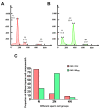The Loss-Function of KNL1 Causes Oligospermia and Asthenospermia in Mice by Affecting the Assembly and Separation of the Spindle through Flow Cytometry and Immunofluorescence
- PMID: 36904774
- PMCID: PMC10007211
- DOI: 10.3390/s23052571
The Loss-Function of KNL1 Causes Oligospermia and Asthenospermia in Mice by Affecting the Assembly and Separation of the Spindle through Flow Cytometry and Immunofluorescence
Abstract
KNL1 (kinetochore scaffold 1) has attracted much attention as one of the assembly elements of the outer kinetochore, and the functions of its different domains have been gradually revealed, most of which are associated with cancers, but few links have been made between KNL1 and male fertility. Here, we first linked KNL1 to male reproductive health and the loss-function of KNL1 resulted in oligospermia and asthenospermia in mice (an 86.5% decrease in total sperm number and an 82.4% increase in static sperm number, respectively) through CASA (computer-aided sperm analysis). Moreover, we introduced an ingenious method to pinpoint the abnormal stage in the spermatogenic cycle using flow cytometry combined with immunofluorescence. Results showed that 49.5% haploid sperm was reduced and 53.2% diploid sperm was increased after the function of KNL1 was lost. Spermatocytes arrest was identified at the meiotic prophase I of spermatogenesis, which was induced by the abnormal assembly and separation of the spindle. In conclusion, we established an association between KNL1 and male fertility, providing a guide for future genetic counseling regarding oligospermia and asthenospermia, and a powerful method for further exploring spermatogenic dysfunction by utilizing flow cytometry and immunofluorescence.
Keywords: KNL1; asthenospermia; flow cytometry; immunofluorescence staining; oligospermia.
Conflict of interest statement
The authors declare no conflict of interest.
Figures









References
-
- Mora-Bermúdez F., Kanis P., Macak D., Peters J., Naumann R., Xing L., Sarov M., Winkler S., Oegema C.E., Haffner C., et al. Longer metaphase and fewer chromosome segregation errors in modern human than Neanderthal brain development. Sci. Adv. 2022;8:eabn7702. doi: 10.1126/sciadv.abn7702. - DOI - PMC - PubMed
-
- Stiff T., Echegaray-Iturra F.R., Pink H.J., Herbert A., Reyes-Aldasoro C.C., Hochegger H. Prophase-Specific Perinuclear Actin Coordinates Centrosome Separation and Positioning to Ensure Accurate Chromosome Segregation. Cell Rep. 2020;31:107681. doi: 10.1016/j.celrep.2020.107681. - DOI - PMC - PubMed
MeSH terms
Substances
LinkOut - more resources
Full Text Sources
Molecular Biology Databases
Research Materials

